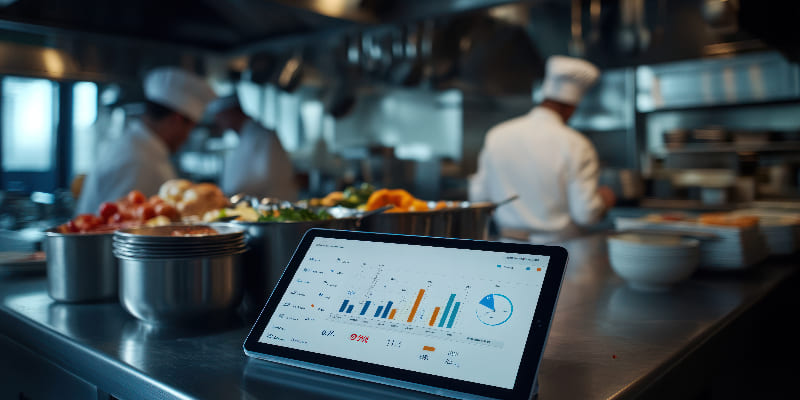

Instagram is still the beating heart of visual storytelling. For restaurants, it’s where taste meets technology.
According to Lee, Kang & Namkung (2021), the quality and trustworthiness of food posts on Instagram directly affect how people share and decide what to eat. Meanwhile, one Sustainability study by Bushara et al. (2023) has proven that interactive, trend-based restaurant social media marketing increases willingness to pay and dining intent.
What's different in 2025? Everything from how one finds out the trending flavors to which Reels are about to go viral is underpinned by Artificial Intelligence. The algorithm favors Reels, interactive Stories, and posts optimized for alt-text, rewarding creativity powered by smart data.
Meta’s recent regional studies show Reels dominate daily video consumption in many markets, while platform benchmarks report average Instagram engagement rates around 1.8–2.4% and Reels outperform other formats on reach and watch time. Additionally, industry benchmarking shows marketers using generative and automation tools reduce content production time by roughly 50–60%, allowing for more rapid trend responses.
For example, Sweetgreen has invested in predictive analytics to help the company schedule seasonal salad launches. Domino's Pizza uses AI captioning tools to auto-personalize Reels for different countries.
Small restaurants and cloud kitchens are already embracing AI. In India and beyond, independents use AI video templates and auto-editing tools to produce Reels and regional captions in hours, not days. Many rely on tools like ChatGPT or Hootsuite’s OwlyWriter to localize captions and test CTAs, helping lean teams run quick A/B campaigns that once needed full agencies (Truefan, 2025).
The feed is still your restaurant's visual identity. It's the first impression for potential customers and investors alike. Fusté-Forné (2025, Elsevier) stresses that the aspects of authenticity—chefs in action, ingredient sourcing, and community stories—are those that actually resonate much more than staged photography.
Actionable local SEO & accessibility tips for restaurant social media marketing:

To enhance your restaurant's social media marketing feed:

Reels remain Instagram’s most powerful tool for organic reach. Pereira (2025, Cogent Business & Management) found that influencer-driven food videos directly influence Gen Z’s dining choices.
AI tools such as Meta Creative Studio and Hootsuite IQ now suggest trending sounds, best posting windows, and hashtag clusters, giving marketers an edge in timing and tone.
The most effective Reels for Instagram for food brands feature:
Starbucks Japan mastered this by posting Reels featuring its new Sakura drinks, using trending local music and slow-motion pour shots. Each clip averaged over a million views, all powered by algorithmic timing and AI-caption optimization.
Artificial intelligence has redefined restaurant social media marketing into a data-driven discipline. AI now informs creative decisions, not just automates them.
Meta’s built-in AI tools analyze engagement data from millions of posts. They now forecast how likely your Reel will perform before it’s published. This predictive insight allows food brands to:
Restaurants using Meta’s AI scheduler report an average 28% higher engagement than manual posting. McDonald’s uses it to localize campaigns. For example, promoting a McSpicy Reel at lunchtime only in hot-weather regions.
Generative AI is now the sous-chef of digital storytelling. Tools like Runway Gen-2, Adobe Firefly, and Canva Magic Studio create hyper-realistic images or micro videos from text prompts.

For Instagram for food brands, this means turning a phrase like “caramel dripping over a molten brownie” into a ready-to-post slow-motion clip in minutes.
MorningAI (2025) reports that food marketers using generative AI cut content production time by 60% while maintaining visual quality. Burger King Brazil, for instance, used AI-generated imagery for its “Impossible Whopper” Reels, blending real footage and AI animation, the result: a viral campaign with a 35% engagement spike.
The Instagram algorithm now prioritizes completion rate, saves, and accessibility over vanity metrics like likes.
Key KPIs to monitor include:
Use AI dashboards (Later AI, Sprout Social Indexer, Hootsuite) for hourly first-90-minute velocity, and set automated alerts when a post reaches 20% above baseline engagement so you can boost or iterate quickly. Real-time analytics from platforms such as Later AI and Sprout Social Indexer facilitate brand adjustment in visuals, captions, or posting schedules.
Quite simply, AI converts engagement into insight and insight into growth.
The future of Instagram for food brands is immersive, intelligent, and interactive.
Now, small restaurants create movie-like cooking clips from basic text prompts; this will be widely adopted in mid-tier franchises.
Diners preview dishes using Instagram filters. This was pioneered by KFC India, and the chain has seen its menu interaction rate increase by 25%.
Posts are now discoverable by voice thanks to alt-text; for example, "show me the best sushi spots near me."
Establishments using city-specific keywords, tags, such as PizzaRestaurantsBangalore, #NYCBurgers, or #DelhiEats, tend to see quicker organic discovery.
Posts of local sourcing or zero-waste kitchens perform better than pure promotions.
Success in 2025 has a very simple, yet powerful formula: a blend of human emotion and artificial intelligence. Those that are going to nail Instagram are the food brands that will make use of AI as a creative collaborator, able to predict what audiences want even before they search for it. By weaving in storytelling, predictive analytics, and AR-driven experiences, restaurants will turn engagement into foot traffic and loyalty.
In this new ecosystem, Instagram isn't just a social tool but the heartbeat of digital marketing for the food industry, fueling creative, effective, and measurable growth grounded in data.